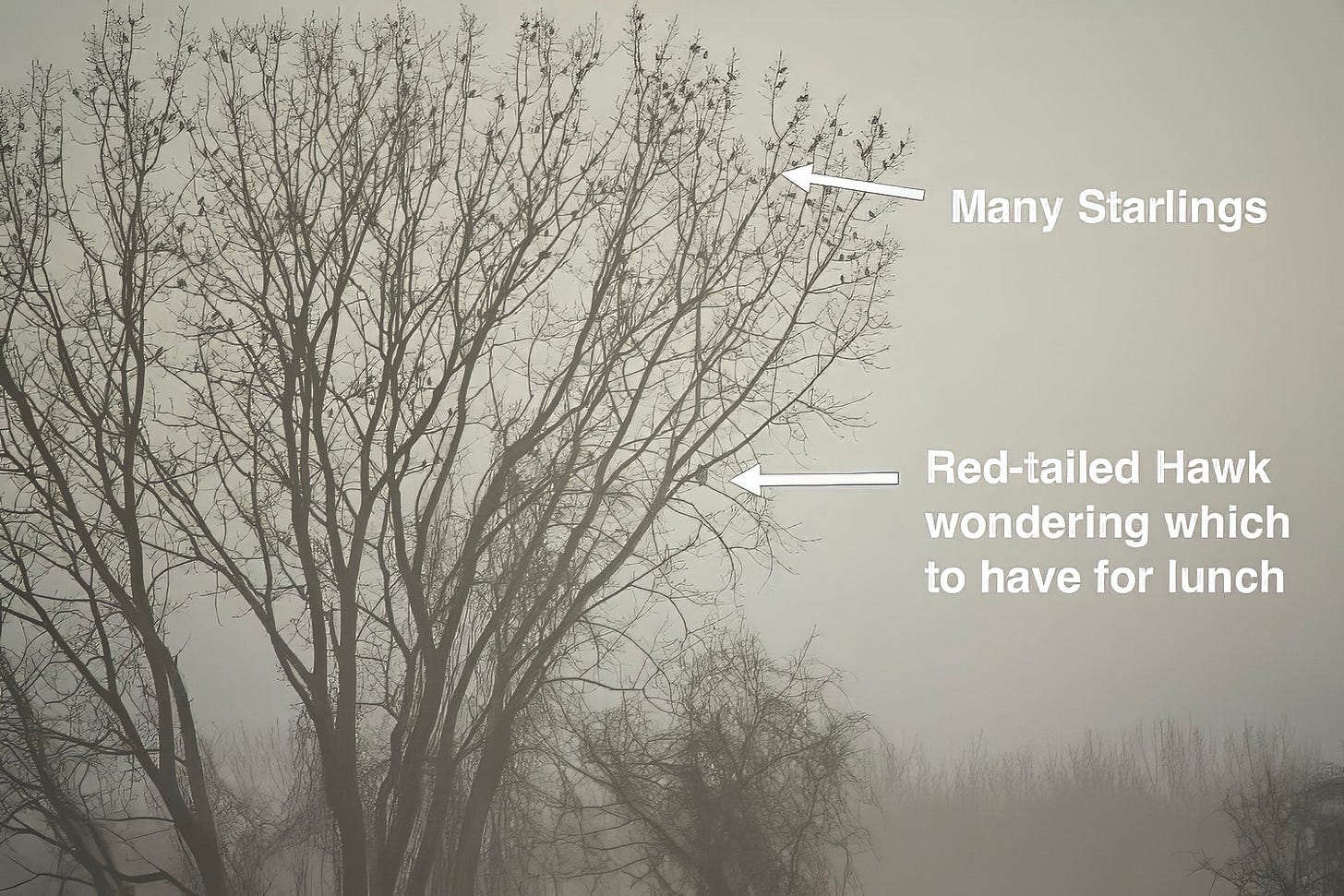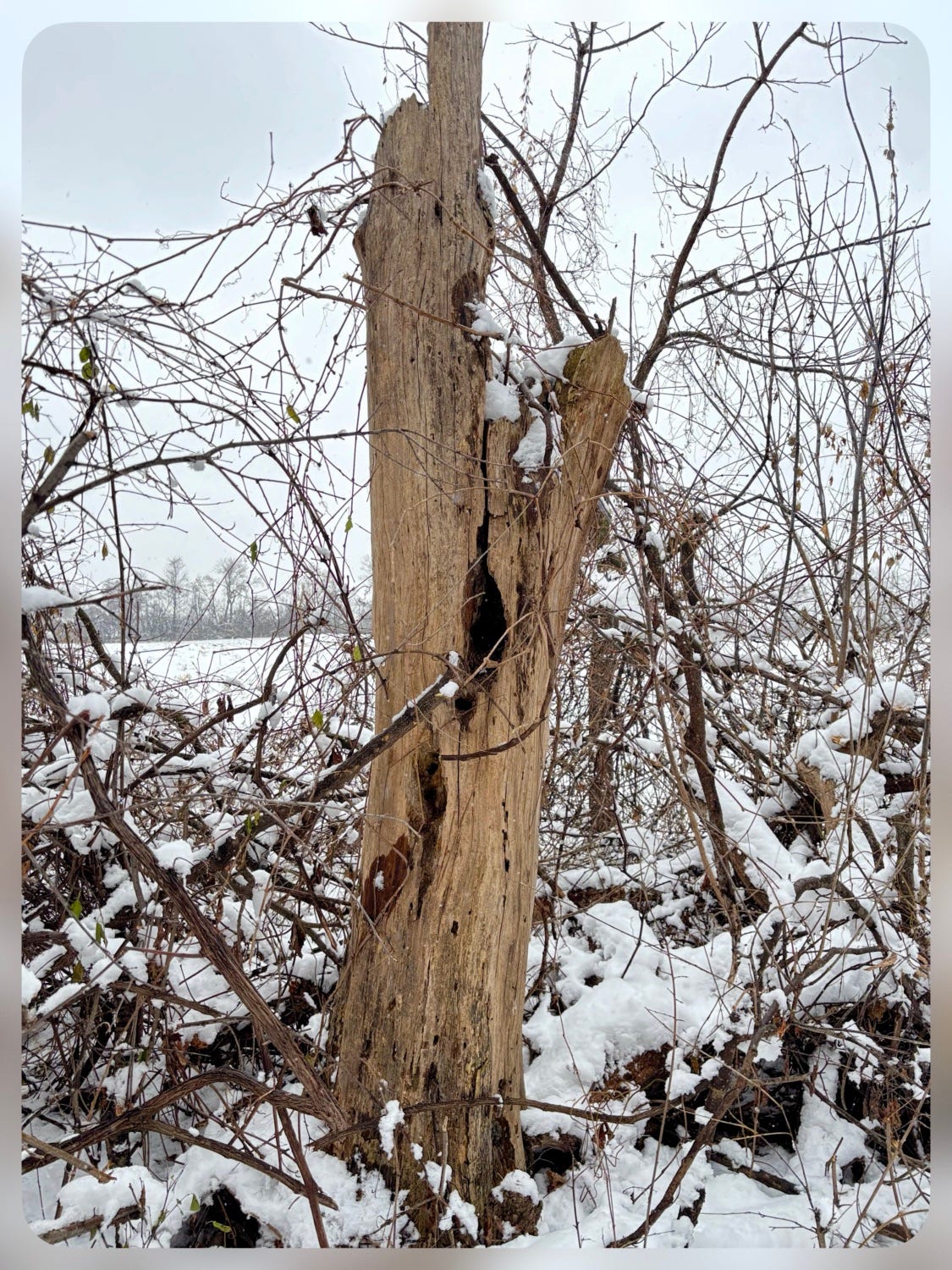On Thursday the snow finally arrived - only a few inches but it’s a start.
Wrong place, wrong time
This Brown-headed Cowbird, ought, by rights to be down on the way to, or near, Central America by now, but it looks healthy enough.
Needlessly Wasted Food
At this cold time of the year there is not a lot to write about here concerning our native plant gardens, bees and butterflies. Consequently I want to use some space this week to draw attention to an editorial that appeared in the Globe & Mail during the week. It may be behind a paywall, so I will share the entire article here. The title was “The right way for companies to take out the trash”. It is certain that the theme of this piece applies equally to every other country on the planet, not just the one I live in, nor the one I left. I am sorry to be quoting so extensively rather than writing for myself, but the original author made the necessary points very well and this is something that matters in today’s world.
In a country where too many go hungry, too much food is going into the garbage. It’s part of a larger problem of waste by companies, for whom throwing away inventory is too often the cheapest choice. In October, research by Second Harvest found that nearly half of all food in Canada is wasted every year. Of that waste, 41.7 per cent was avoidable – much of which could have been redirected to people in need – with an estimated value of $58-billion. The study from the non-profit notes that 13 per cent of avoidable food waste happens in retail. This, at a time when food banks are crying out for donations to meet surging demand.
Over the past two years, reporters from Quebec news outlets Les Coops de l’information exposed what retail waste can look like. In early 2023, they went behind a Couche-Tard convenience store to do dumpster diving – digging into trash in search of food. What they found was shocking: hundreds of recyclable aluminum cans and plastic bottles, still filled with soda, milk and water, among other drinks. All were bound for landfills. They found the same thing throughout the province. Employees confirmed this was standard practice.
Many stores hide their waste in compacting dumpsters or behind locked gates, but Couche-Tard is not alone. The same team found thousands of new products – soap, clothes, electronic devices, etc. – and still edible food such as chocolate, crackers and noodles in Dollarama dumpsters. Many items were intentionally damaged with a box cutter to make them unusable. Les Coops also investigated Home Depot stores, which throw away and destroy thousands of unsold products. In 2016, CBC’s Marketplace found huge quantities of fresh food in GTA Walmart stores’ garbage.
Such behaviour is not prohibited, but it should not be condoned. Amid the climate crisis and continuing affordability concerns, governments should step in to legislate and adjust the financial incentives for businesses to avoid waste.
Canadians are among the world’s biggest producers of garbage per capita, standing at a dismal second place for the amount sent to landfills, just behind New Zealand. This depletes natural resources, increases greenhouse gas emissions and puts pressure on overflowing dumps.
But why do otherwise? In Canada, it is perfectly legal – and affordable – to waste. A 2022 report on Quebec’s waste management by the BAPE, which holds public hearings on environmental issues, notes that most businesses need to contract privately to have their garbage picked up. As participants observed, landfills are often the cheapest option.
In response to Les Coops’ reporting, Couche-Tard issued a statement saying it is “complying with all applicable laws and regulations regarding waste management and recycling.” Dollarama’s CEO said what the reporters saw was “exceptional” and that the company would do more to address food waste. Some grocery stores give to food banks shortly before expiration dates, while others put products at discounts on anti-food waste apps. But we should not rely on corporate goodwill alone. The worst of current default options should be outlawed.
Last year, the Parti Québécois, a provincial opposition party, tabled a bill that would have prohibited the voluntary damaging of unsold goods, forced retailers to give them away or, if that was not possible, sign recycling deals. It had teeth: fines were up to $1.5-million. The bill went nowhere.
The PQ drew inspiration from France, which adopted a pioneering anti-waste law in 2020. It was not a panacea; a recent report found issues with implementation. But the French – who already generate a lot less waste per capita than Canadians – tried something.
Or governments can use incentives, both positive and negative. The Canada Revenue Agency offers a tax credit for “gifts out of inventory,” but this carrot seems insufficient by itself. Sticks should be considered, starting with increasing the fees for garbage disposal. If the cost of sending waste to landfills took into account the environmental impact, that would make other options more attractive. The next time Couche-Tard gets rid of soda cans, it should cost more to send them to the dump than emptying and recycling them.
Reducing food waste is good for the environment and can benefit the most vulnerable. Governments can help by ensuring that doing the right thing is also the profitable thing.
Gradually more and more people are reducing the areas of our gardens that are mown grass and the world seems to be reasonably content to see non-native dandelions take over - those yellow flowers make people feel that they are helping the environment, when in fact, it’s not quite so simple as this link explains:
https://www.cleannorth.org/2021/04/08/the-common-dandelion-bee-saviour-or-pesty-invasive/
“We are feeding the bees!” Dandelions didn’t exist on this continent before Europeans, so they are unnecessary for native bees. In fact, dandelion pollen is detrimental to native bees. When dandelion pollen was fed to solitary bees, larval development was stunted or incomplete.
“Dandelions are the bees first food” Nonsense! Many plants bloom long before dandelions show their yellow faces.
Please think about this when making plans for your 2025 garden. Plant natively and with deliberation rather than let yellow aliens take over by doing nothing.
Actually, this is mostly about things we are looking forward to seeing in the remainder of 2024 as we go Out Walking rather than things seen this week. It’s rather quiet right now, so time to anticipate a bit.
Looking forward to …
Many, not quite most, but many winters the flat lands to the west of Montreal attract wandering Snowy Owls which are always a treat to see. So far this year, I am not aware of any reaching us so far but I am always cheerfully confident and anyway, it’s an opportunity to share a photograph of a star species. Our flatlands are really flat and provide winter hunting opportunities for birds that spend the rest of their lives on the northern tundra - which is equally flat.
This splendid specimen was seen a year ago - sitting right at the top of a tall tree while disdainfully sneering at me and my camera. I guess I wasn’t a threat.
Always wise to take binoculars, wherever you wander. Rather distant, but an interesting conjunction of predator and prey here was almost lost in the distance. Hard to think that the Starlings were unaware of the presence of the Hawk, but they seem assured of their ability to outfly him should the need arise.
This week, whilst out walking. While taking these pictures a Red-tailed Hawk was circling, a Raven was calling and a largish flock of Snow Buntings had just passed overhead. Small things, but a joy.
Too noisy, but the wrong sounds.
I came across this a few days ago. I am especially conscious of sound in the world as I expect to be depleting my bank balance by picking up new hyper-clever hearing aids with AI assistance in a few days, so this spoke to me. One question it addresses is “when did the world get so loud” and on the other hand “what happened to the sounds of nature”. Not a long read, but interesting and concerning.
Scientists who use ecoacoustics to measure habitats and species say that quiet is falling across thousands of habitats, as the planet witnesses extraordinary losses in the density and variety of species. Disappearing or losing volume along with them are many familiar sounds: the morning calls of birds, rustle of mammals through undergrowth and summer hum of insects … The dawn chorus of my youth is radically different now, but I’m only comparing it with something that was already greatly depleted. The dawn chorus in the same place 50 years ago must have been deafening and magical. Go back another 50 years and it would have been like being on another planet.














So many birds on the bare tree look like flowers in bloom. Are they all starlings?
Here in the UK, we love our dandelions and here they are great for insects! But, I can guess how bad they must be over there as an invasive non-native.
And I'm constantly appalled by the wastage of food and other stuff.